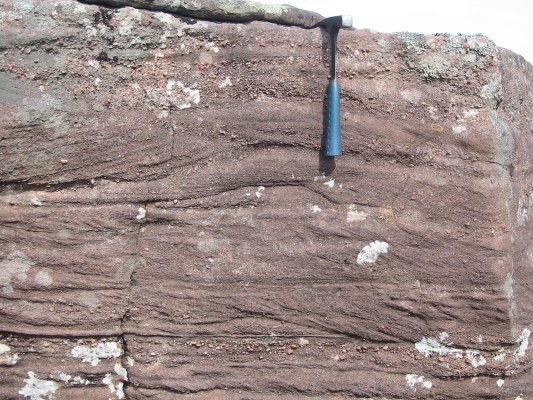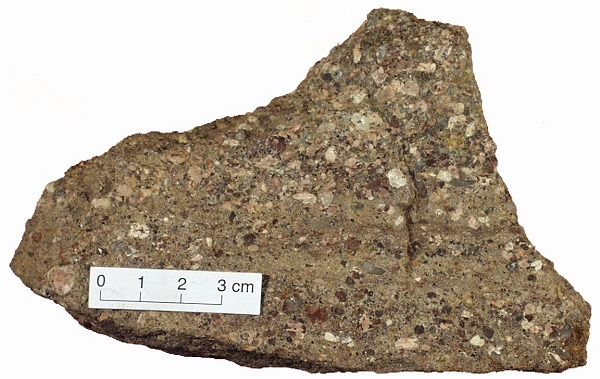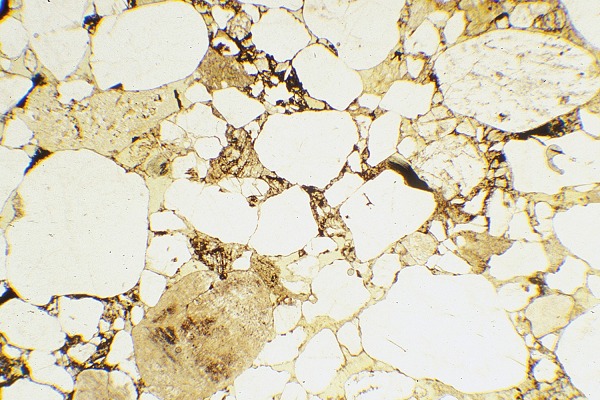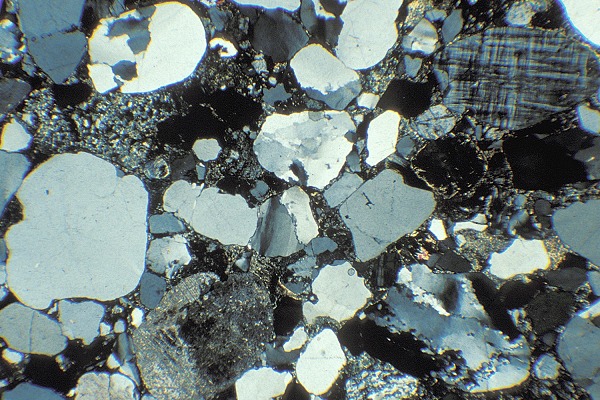
| Home | Geological History | Stratigraphy | Area map | Rock Index | About |
| Scourie | Achmelvich | Laxford | Clachtoll | Stoer | Assynt | Skiag Bridge | Glencoul | Knockan | Borralan | Ledmore |
From roadside outcrop on the north shore of Loch Assynt

![]() Coarse feldspathic sandstone, Torridon Group
(Torridonian)
Coarse feldspathic sandstone, Torridon Group
(Torridonian)
This outcrop of coarse-grained purplish-red sandstone
shows the structure known as cross-bedding.
Prominent bedding planes (forming shadows on the rock face)
are horizontal and spaced about 10 cm apart. Between these
planes, and at an angle to them, you can see a fine
layering, often marked by changes in grain size, dipping
down to the right or to the left. Cross-bedding like this
is common in the sediments laid down by broad, shallow
rivers, where the water flows in many small channels
separated by sand bars. Sand is deposited in the channels,
and the streams migrate sideways, to and fro across the
course of the river, leaving behind the layers of sand that
formed on the sloping channel sides. Hammer shaft is 30cm
long.

![]() Coarse feldspathic sandstone, Torridon Group
(Torridonian)
Coarse feldspathic sandstone, Torridon Group
(Torridonian)
This hand specimen shows characteristic textures of the
coarse-grained Torridonian sandstones. The rock is made of
alternating coarser and finer layers. In any one layer,
however, there is a mixture of coarse and fine material -
the rock is poorly sorted. The coarse grains are of
many different colours, from white to dark red-brown, and
are clearly composed of different materials. In fact,
feldspar is as abundant as quartz, and the rock is,
strictly speaking, an arkose or feldspathic
sandstone.

![]() Coarse feldspathic sandstone, Torridon Group
(Torridonian)
Coarse feldspathic sandstone, Torridon Group
(Torridonian)
This view gives a good impression of the range of sizes of
sand grains. Some are angular, some are more rounded. The
degree of rounding should depend on how much time they have
spent being transported in the river system. Clear grains
are mostly quartz, cloudy grains are feldspar. Dark iron
oxide material forms a thin coating on the grains and makes
up part of the matrix or cement, giving the red-brown or
purplish colour to the rock.
Plane polarized light, field of view 7 mm across.

![]() Coarse feldspathic sandstone, Torridon Group
(Torridonian)
Coarse feldspathic sandstone, Torridon Group
(Torridonian)
Between crossed polars we see the great variety of
different types of material making up the grains. There is
quartz (e.g. large grain at left), potassium feldspar with
"tartan" twinning (top right) and fragments of various rock
types including quartzite, sheared quartzite, and Lewisian
Gneiss. Some of these rocks occur nearby, such as the
gneiss. Others, like the quartzites, do not, and must have
been brought down the rivers from much further away.
Crossed polars, field of view 7 mm across.
| Scourie | Achmelvich | Laxford | Clachtoll | Stoer | Assynt | Skiag Bridge | Glencoul | Knockan | Borralan | Ledmore |
| Home | Geological History | Stratigraphy | Area map | Rock Index | About |
D.J. Waters, Department of Earth Sciences, May 2003